Back in March, while trying to meet a friend for drinks, I ended up walking in the NYC Dyke March. It wasn’t what I’d set out to do originally, but hey – she wanted to participate and it was easier for me to meet her on the route.
Admittedly, it was tenser than I’d expected as the march had shifted focus to being about both queer pride and reproductive rights. Who could blame them? By overturning Roe v Wade, the Supreme Court had effectively hurled half the country’s abortion legislature back sixty years – so the crossover was on everyone’s mind for obvious reasons. The first thing my friend and I talked about was how much the Supreme Court sucked.
We only walked a few blocks with the march itself, but I couldn’t help but feel awkward the whole time. It wasn’t because I disagreed with the march by any means, but because at the time I felt like a fish out of water. I couldn’t help but worry that perhaps someone would raise an eyebrow about why I was walking there—there weren’t a whole lot of guys in the crowd, after all.
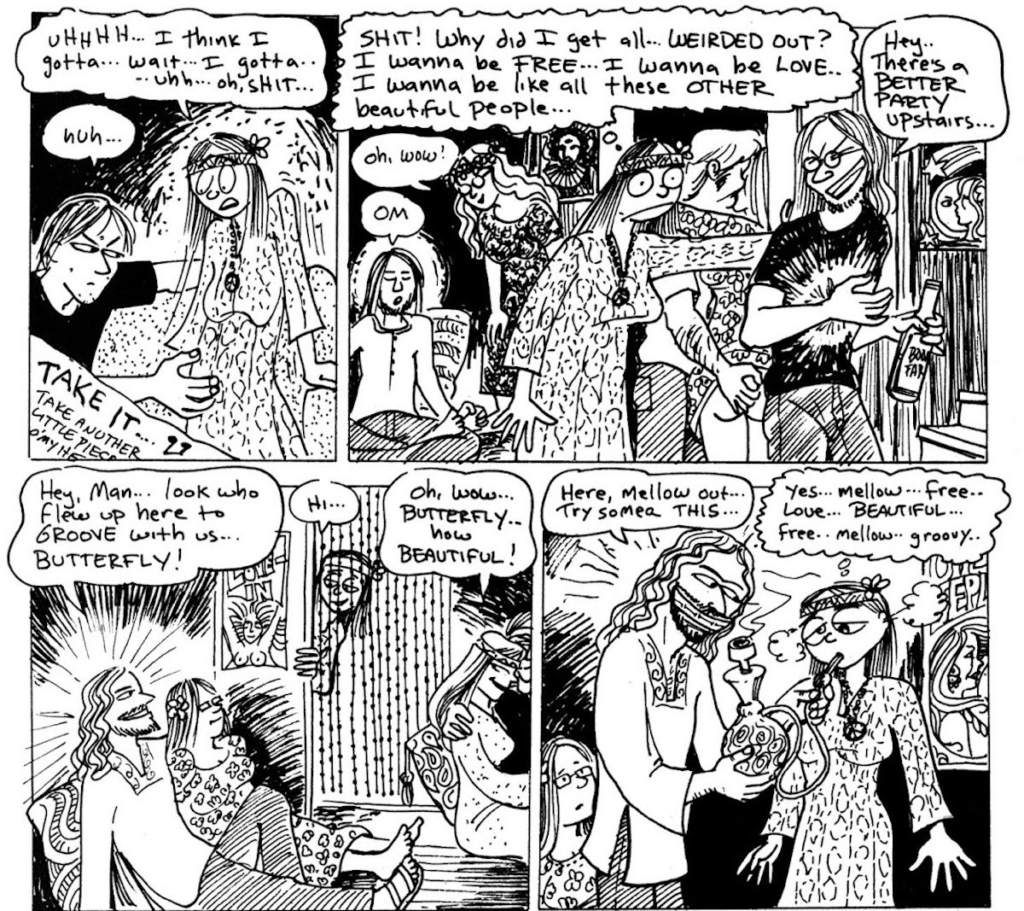
Of course these were irrational fears, and ones that I’m sure many other cis men have experienced as well – the worry that in trying to support, you’re accidentally creating more of a problem. Usually when the topic of reproductive rights comes up, it’s treated as a sensitive topic that gets people riled up right off the bat – I think that’s why so much mainstream media relies on melodrama to tell their abortion stories; to try and treat a serious issue as sensitively as possible. The only problem is that, in the process of trying to create a bigger and more serious conversation, this only makes it harder to talk about abortion overall in a way that people can understand on a larger scale.
There’s such an aura of somberness that people will avoid engaging with the topic. Even worse, if emotions are too intense, audiences will want to keep a safe empathetic distance from the characters in the story. I admit that in the past I’ve felt that reading up on abortion can be emotionally draining – more like homework to understand something that doessn’t affect me directly – and that’s part of the problem. We need more media to break the ice! Which is why I think Roberta Gregory’s Abortion Trilogy left such an impression on me.
If you haven’t heard of Roberta Gregory, I wouldn’t be too surprised. She’s more prolific in the underground comix community than anywhere else, appearing sporadically in the feminist collective anthology Wimmen’s Comix and more regularly in Gay Comix – Howard Cruse’s all-queer, long-running comics anthology. Despite the collections of her solo series Naughty Bits having been out of print for some time, I had – thanks to my local used bookstores – read some of Gregory’s work in the past; most importantly her infamous “Crazy Bitches” story.
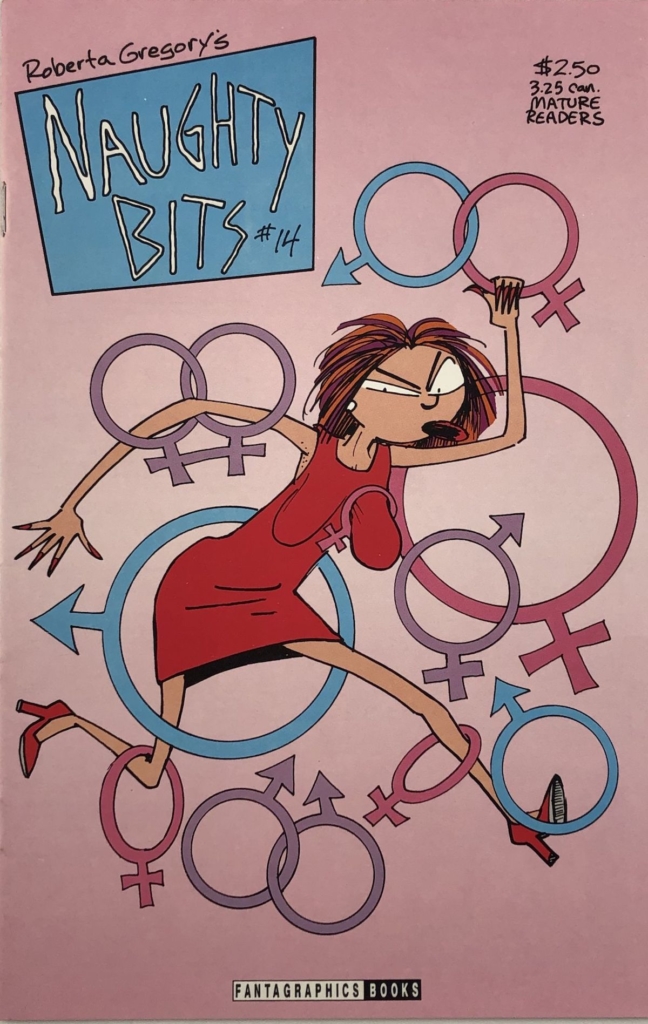
For the uninitiated, the plot is simple: a husband is caught reading one of Robert Crumb’s more misogynistic comics and defends it against his wife and her friends, saying it’s an exaggerated parody of men’s hostility towards women. How do the women respond? They kick him in the balls, gag and rape him, bite off his dick, shit on his face, then share a lovely cup of tea to wind down.
I actually liked the story a lot. Sure, it was exaggerated and made me feel a little guilty (as I actually like plenty of Crumb comics myself), but there was a level of truth and playfulness to it. This wasn’t an attack on men or even on Crumb; Gregory understands that comics are the perfect medium for expressing exaggerated feelings. It’s like watching a horror movie with buckets of blood: when the violence is so out of this world, the only way we can respond is to laugh. In this same way, Gregory’s exaggerated style is what really makes The Abortion Trilogy.
Serialized in issues 6-8 of Naughty Bits, the Abortion Trilogy follows her most recognizable character “Bitchy Bitch” in her teenage years, when she was still mild-tempered Midge McCracken aka “Hippie Bitch”. The story has three parts: “Hippie Bitch Gets Laid,” “Hippie Bitch Gets Knocked Up,” and “Hippie Bitch Gets an Abortion.” The titles don’t leave much to the imagination and there aren’t too many surprises hidden in the plot, which is what makes these stories even more impressive. Gregory’s “in-your-face” cartooning style makes understanding the emotions associated with abortion accessible and funny without dumbing down or obscuring reality.
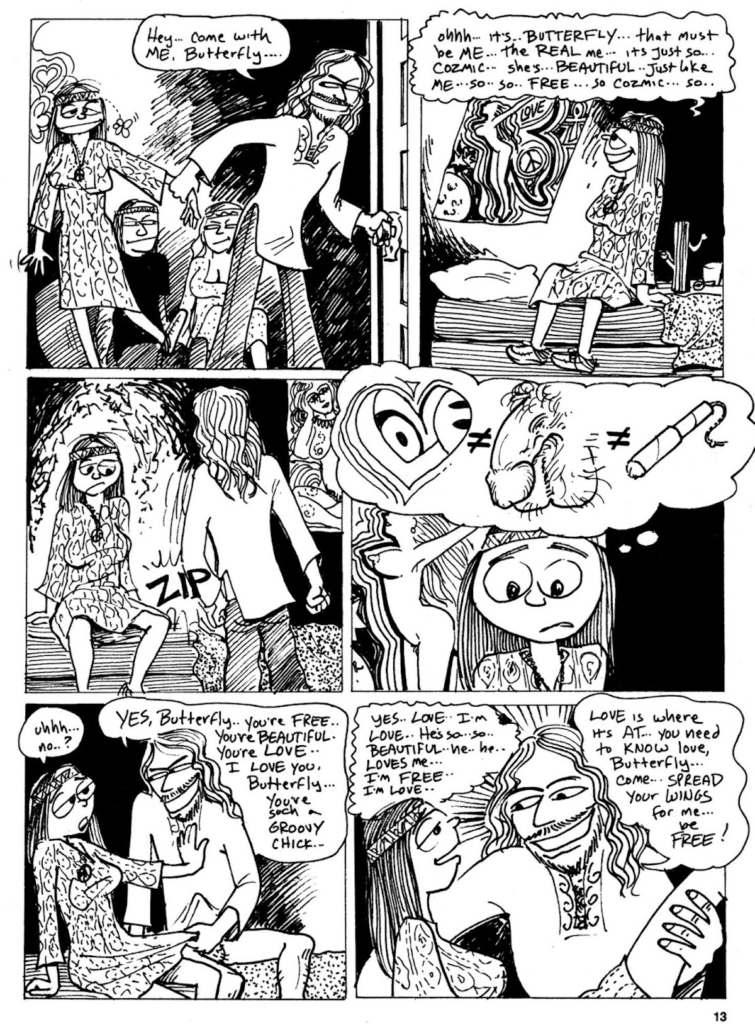
In the climax of this first act of “Hippie Bitch Gets Laid” – the first installation of the trilogy – Midge is at a college party and is taken upstairs. A boy gives her something to smoke and she’s immediately high as a kite—her giant pupils and goofy smile say it all. Her face immediately changes when the boy unzips his pants and whips it out, and a thought bubble appears over her head with a simple equation: heart does not equal penis does not equal tampon.
There’s an immediate and abstract quality that gives images more emotive power. The heart has the word “love” written inside with hippie curves, showing that her understanding of love is tied to an unspecified concept of the word more than anything tangible. Then there’s the other side of the equation with the tampon: earlier in the story Midge triumphantly proclaims that she’s a woman after using a tampon for the first time. It’s a symbol of newfound maturity. These both do not equal the penis, representing sex, relationships with men, and indeed, what’s right in front of her. Readers aren’t expected to process all of this analytically, they’re just supposed to think “oh no, she isn’t ready for this.” The thought bubble perfectly captures that complex emotion when you’re shocked and have only semi-processed what’s happening in front of you.
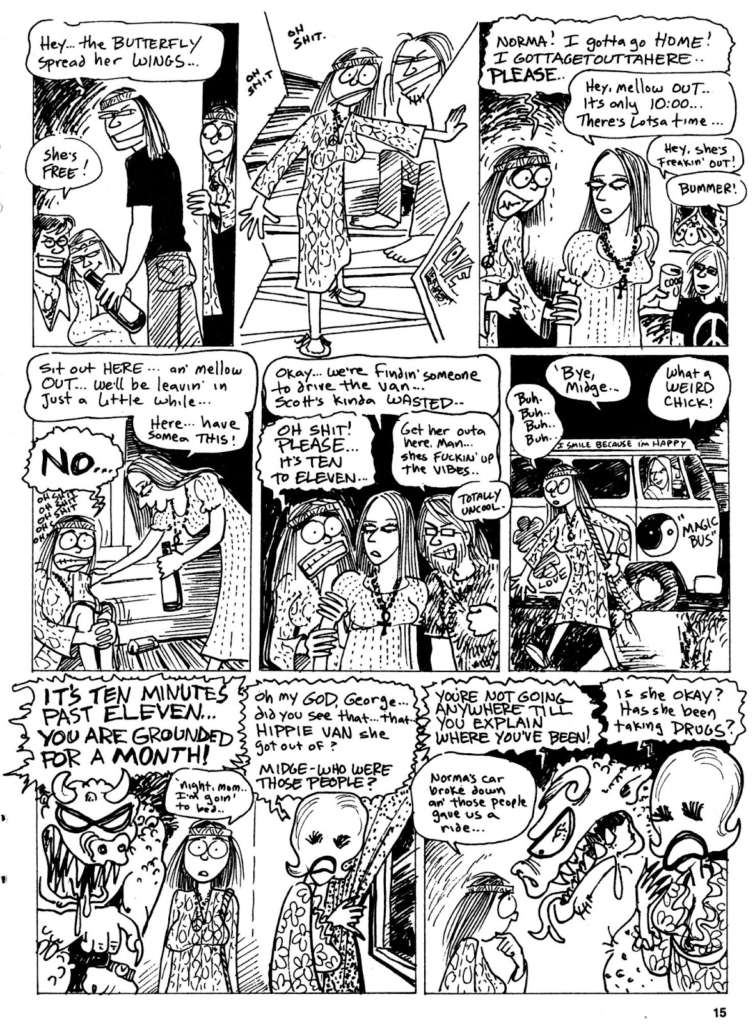
Midge says “no” to the boy, but he pressures her further, saying she won’t be “groovy” and “free” if she doesn’t let him do this (and though the word “rape” isn’t used anywhere on the page, it’s clear that Gregory’s trusting the reader to know exactly what’s going on.) While he’s inside her, Midge grits her teeth and has another thought bubble appear above her head, where we see a camel stuffed half-way through the head of a needle.
Instead of distilling a complicated emotion into a single image, this thought bubble visualizes a verbal metaphor. We know that fitting a camel through the head of a needle means forcing something where it can’t fit, but seeing it has that emotive oomph that words can’t describe. As someone who’s never had this experience, the image certainly left me cringing with an uncomfortable understanding . The thought bubble amplifies Midge’s already pained expression in a way that’s so visceral, it becomes sort of funny even if the situation isn’t.
This doesn’t mean reality (emotional or physical) is dropped entirely. Midge comes out of the event feeling unbalanced and shocked. She asks for a ride home, verbalizes her thoughts when she has more time, and feels depressed the next couple of days. Even if abstract emotions are being drawn in a funny way, those emotions still feel real.
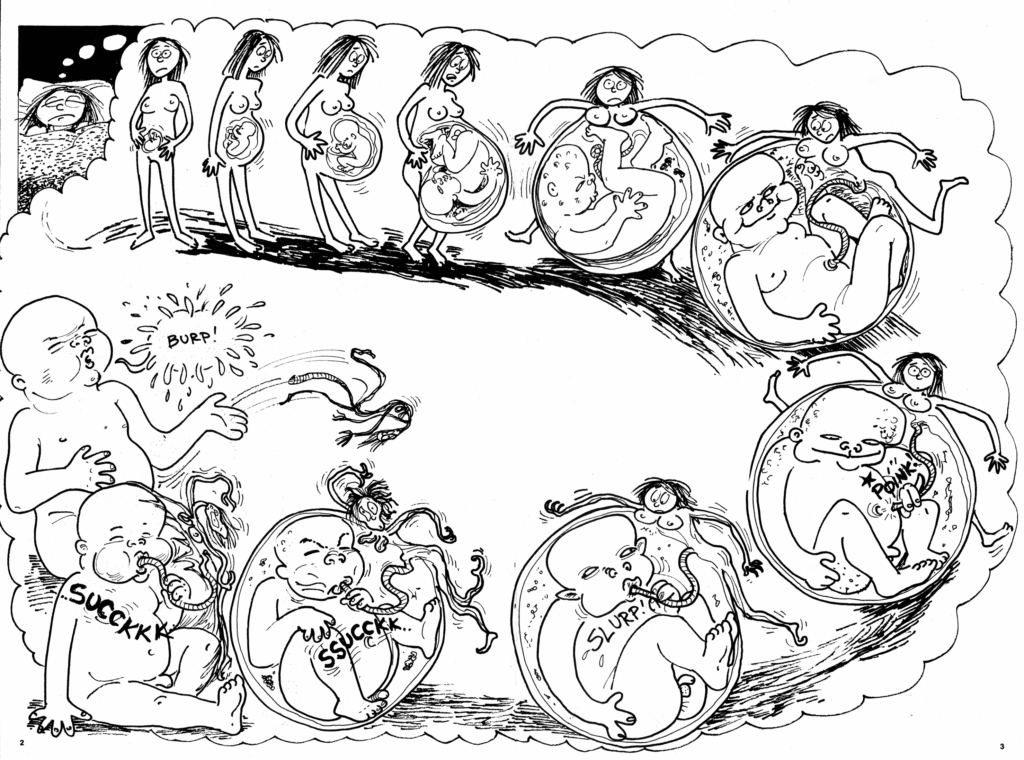
Emotional amplification is the lifeblood of this comic. Gregory isn’t afraid to go full Looney Tunes with Midge—her feet will turn into circular blurs while running away, her body will turn into wavy spaghetti if a boy notices her, her mouth will pucker into an asterisk if she’s feeling queasy. Of course this isn’t literal, it’s more done to externalize internal emotions (she feels so much inside it that has to come out.
Midge’s exaggerated emotions become extremely apparent in “Hippie Bitch Got Knocked Up”, where she frantically asks her friends Norma and Barb for advice on how to get rid of her pregnancy. Midge’s face goes from anxious to terrified to mortified from panel to panel as her friends go over options (going across the border for a legal abortion, risking getting the procedure done by a local, unlicensed doctor, falling down the stairs after a hot bath, etc.) Norma and Barb both seem concerned but somewhat detached from Midge’s situation; they share their thoughts with tiny frowns. Compare this to Midge, who goes from crying panic to screaming hysteria when she’s asked if her parents know.
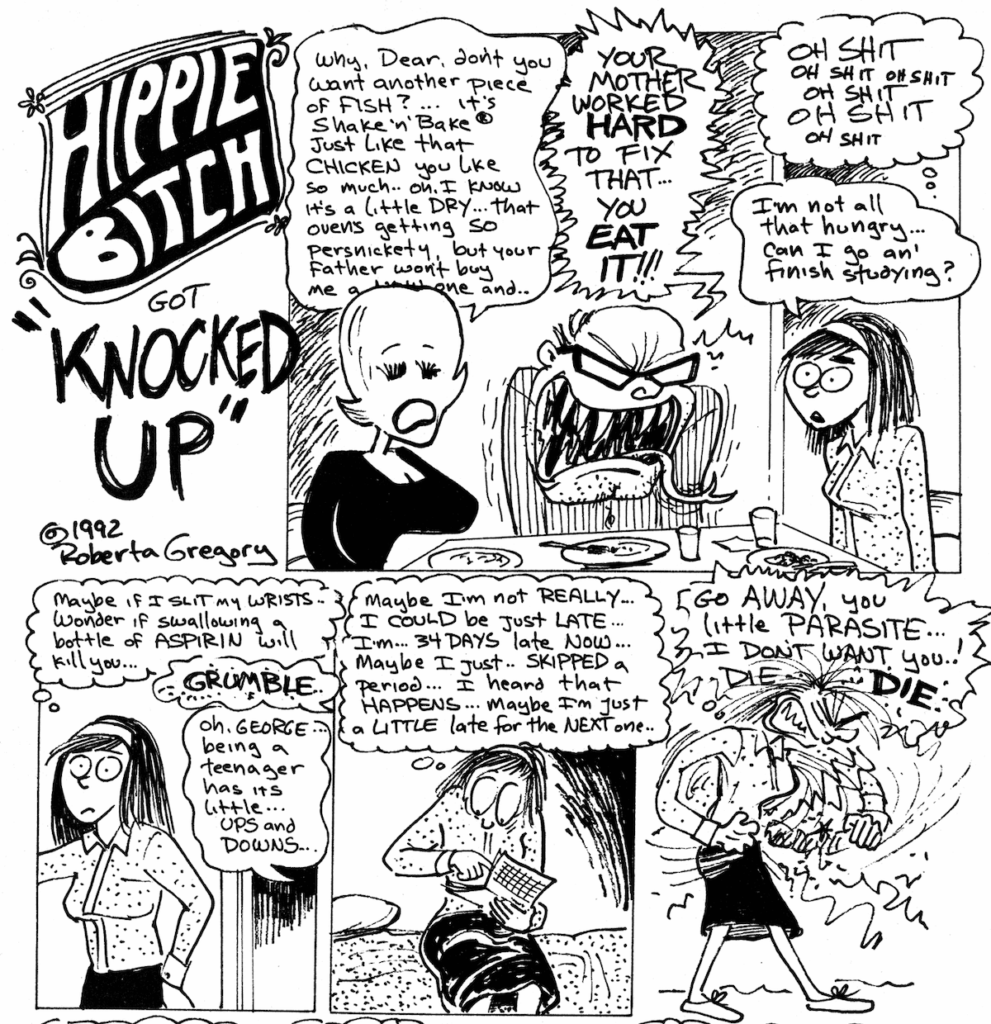
For someone who hasn’t, and is physically unable to be, in her situation, seeing Midge’s body transform to fit her fear communicates those emotions in a way I think anyone can empathize with regardless. There’s really no question on how Midge feels: her eyes are wide, her mouth gapes wide as she screams, her hair stands on end. Gregory’s expressionistic style makes the emotions feel dynamic and tangible, something that abstract descriptions can’t always accomplish. Seeing Midge go full Large Marge while talking to her friends communicates more than hearing her think “I’m terrified.”
Scott McCloud, comics theorist and my own personal hero, has a theory about why cartoons have such emotional power. In his prolific comics-theory book Understanding Comics, he mentions how humans naturally identify with human-looking things (ever see an electrical outlet and think it looks vaguely like a face? Case and point.) and that we have general ideas of emotions based on eye and mouth shape.
Now look at Midge compared to her more realistically drawn co-stars. Her eyes are practically balloons and her mouth is so big her face isn’t always able to fit it. She doesn’t look realistic whatsoever, but that’s the point. When she frowns, it’s a super frown, when her eyes bulge, we feel super shock. Midge is an empathy vacuum, one that transcends identity.
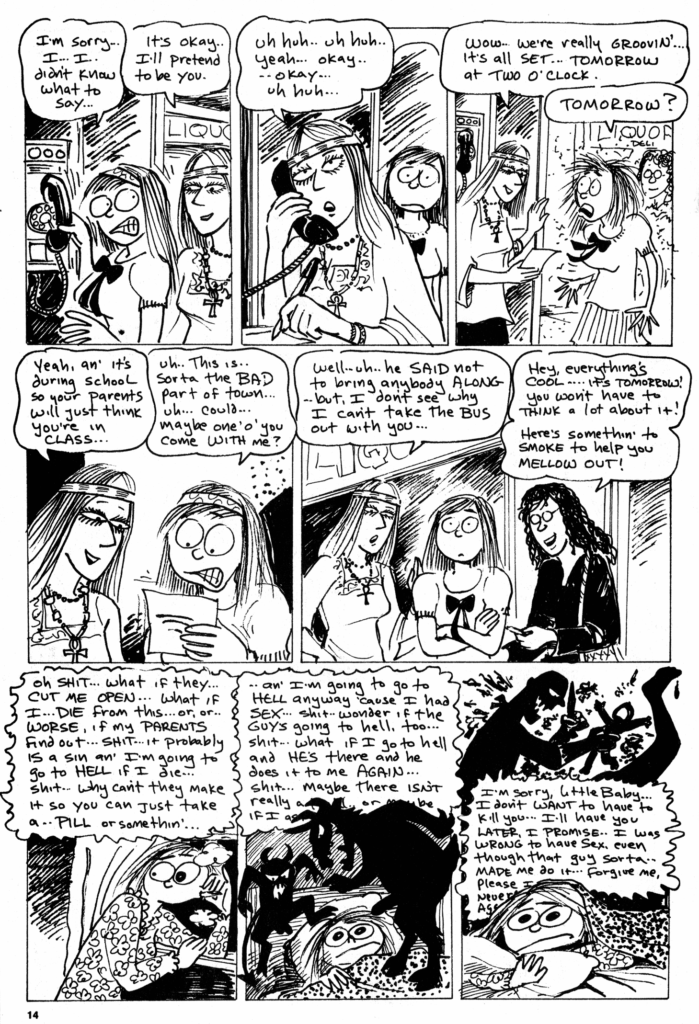
Isolate Midge’s face and she has nothing indicating her gender – a factor that only serves to be more powerful when relating to Gregory’s wider audience. Compare that androgynous face to a drawing appearing in “Hippie Bitch Gets an Abortion.” Right before Midge’s procedure starts, Gregory stops the comic dead in its tracks for a Pekar-style monologue describing how abortions were done in the sixties.
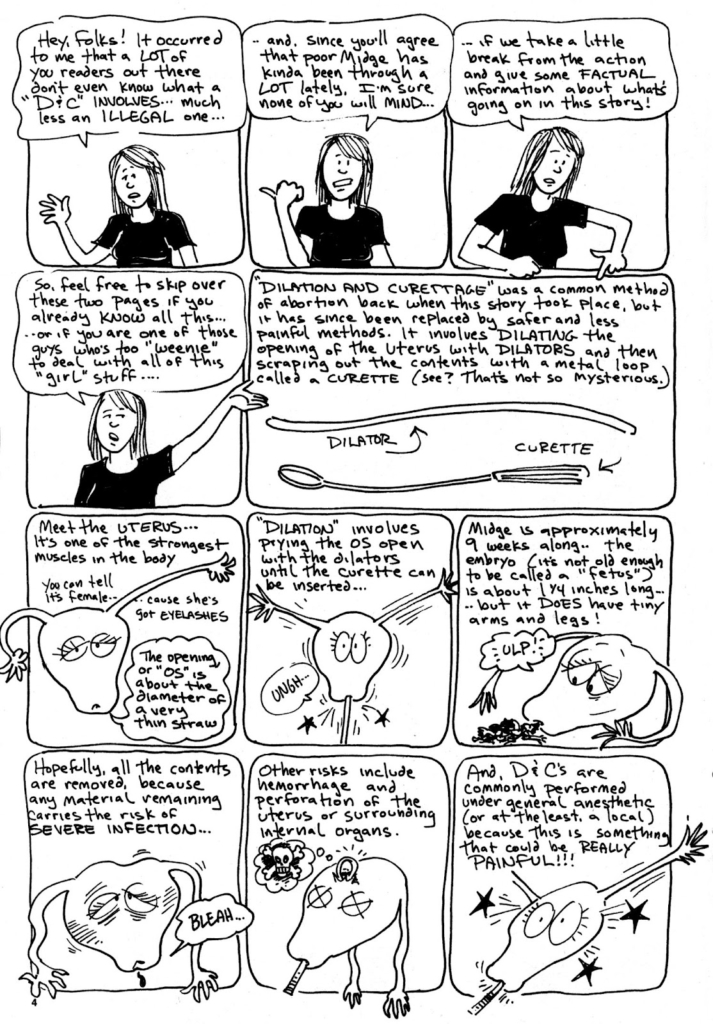
To demonstrate a dilation and curettage procedure (also known as a D&C), she draws a uterus with eyelashes, pointing out how this shows the uterus is, in fact, a lady. Similar to Midge, this uterus is cartoony. When the dilators open up the uterus, her eyes are wide in shock; when the uterus is infected her eyelids are slanted and tired; in probably my favorite image in the book, when Gregory mentions the risk of the dilator or curette perforating the uterus, she draws the uterus with “x’s” for eyes to show she’s dead.
Cartooning works differently with the uterus than it does with the character of Midge herself as a whole person. Beyond being silly, drawing a uterus with eyes also helps make dry information more digestible. Gregory’s prose isn’t terribly fancy or engaging; she explains the procedure with a casual tone but doesn’t add much else.
Adding the uterus, who’s having the procedure done to it, adds an emotion to the information. Seeing the uterus with bulging eyes, outstretched fallopian tube arms, and stars shooting out of it helps to double down on Gregory’s explanation of how painful this procedure is without anesthetic.
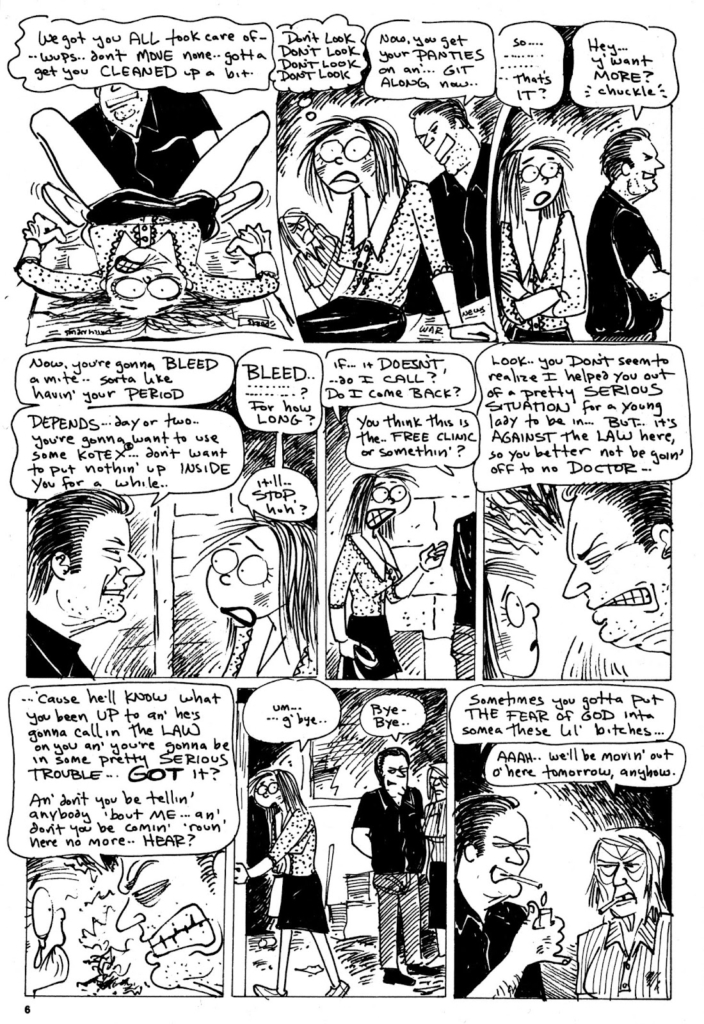
Text and image is what comics are all about, but a diagram wouldn’t have done Gregory’s explanation justice. She preempts her speech by mentioning how “guys that’re too weenie” to hear about these things should just skip her explanation, acknowledging that this is a subject that’s going to be rough for those without the guts to stomach it.
Gregory could’ve just as easily drawn diagrams of a uterus to make her point—after all, there’s probably more neutrality to drawing an organ than giving it a face—but that would’ve turned her explanation into a lecture. She instead turns it into a story, where the character is a bodily organ. It’s infotainment at its finest. Putting a face to the uterus invites the reader in; she takes a chance on explaining a serious topic with such a silly device, but this keeps the reader engaged.
I will always be impressed by how much Roberta Gregory’s Abortion Trilogy remains seared in my mind. The thought bubble of a camel crammed through the head of a needle, Midge’s goofy, terrified expressions when she’s asking her friends for help, the uterus with eyelashes, they’re images I won’t forget.
Not to get too dramatic, but it’s a comic that really turned around my thinking about abortion narratives as a whole. Gregory made a piece of work that uses humor as a means to empathy. She managed to provide information surrounding reproductive rights (how pregnant people are blamed for being irresponsible, the religious implications of “terminating a life”, the fear of being shamed by your peers, etc.) without resorting to an isolating, “after-school-special” tone that has glazed over the eyes of many men and created a narrative that they brush off at the mention of.
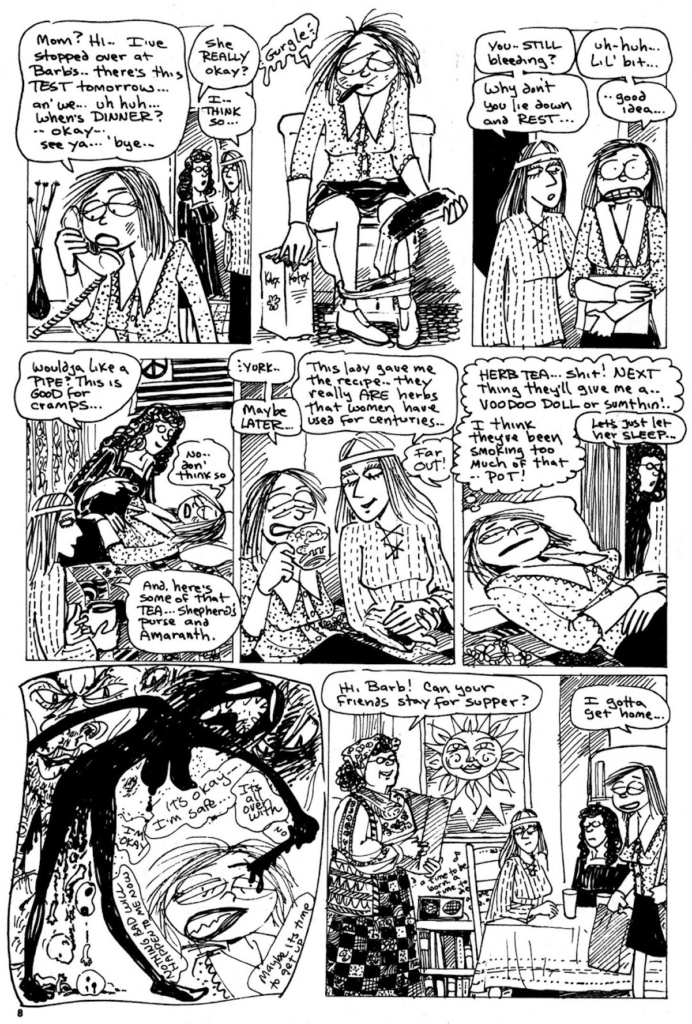
I was so invested in Midge that I unconsciously realized, “if this process was easier, she wouldn’t have had to deal with all these feelings.” It’s a comic that made me look past myself because frankly, Midge’s internal conflict isn’t at all uncommon, and I’m sure having a grasp on these feelings can help me, and people like me, be there for someone in the future if and when the need arises. Roberta Gregory’s comic helped me turn uncomfortable silence into uncomfortable laughter which, for my money, makes great baby steps for those needing to have this conversation.
